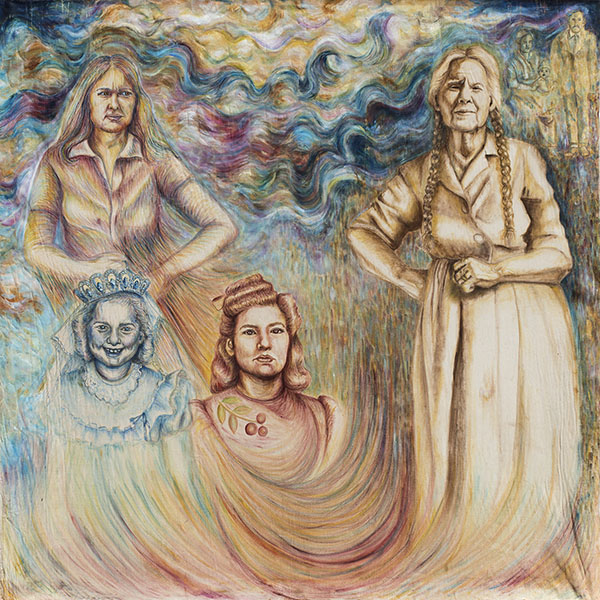Considering the breadth of the work of Judy Baca—a muralist, painter, sculptor and art activist—a comprehensive installation of her work is long past due. The current exhibition contains approximately 120 pieces from the 40-plus-year oeuvre of the LA Chicana artist. Common threads are Baca’s expressions, through her artwork, of the stories of the disenfranchised, minorities and immigrants, their strengths and long legacies, a profound connection to the earth, and especially her belief in the healing power of art.
The exhibition—curated by MOLAA Chief Curator Gabriela Urtiaga and Alessandra Moctezuma, Professor of Fine Art and Museum Studies, San Diego Mesa College—is installed in three sections. The Womanist Gallery contains female-centric drawings, paintings, sculpture, performance and photography. The Public Art Survey gallery includes murals and digital works that Baca pioneered through her Social and Public Arts Resource Center (SPARC), founded in 1976. The Great Wall of Los Angeles gallery features a floor-to-ceiling moving display of her half-mile long wall in the Tujunga Flood Control Channel, San Fernando Valley. Executed by more than 400 artists of all ages from 1974 to 1984, it depicts the history of California through the lens of women and minorities.
Begun in 1980, relegated to storage, but completed for this exhibition is Matriarchal Mural: When God Was A Woman (1980–2021), a triptych in the first gallery. Featuring 13 nude women defying a volcanic eruption, they convey the intense power of women to heal our planet, especially when bonded to each other and to the earth.

Judy Baca, La Memoria de Nuestra Tierra, California, 1996. Courtesy Museum of Latin American Art.
The life-size Las Tres Marias (1976) contains a photo of a Mexican American woman, another of a Pachuca, a flashy woman portrayed by Baca, but the central panel is a mirror—inviting viewers to become the third Maria. Originally installed in LA’s Woman’s Building, it was part of an early Chicana exhibition. The compassionate Tres Generaciones (1973) is a depiction of Baca’s grandmother who raised her, her mother who supported the family, and herself—all strong, resourceful women.
Artworks in the second gallery pay homage to Chicano pioneers including César Chavez. Also displayed is Raspados Mojados (1994), a repurposed street vendor cart addressing immigration, misrepresentation, and discrimination against street vendors through photography and other media. Baca’s painted sculptural Panchos are transformed kitsch objects, originally created for tourists. The artist has instead painted each Pancho with detailed scenes of the tragedies, struggles and victories of immigrants.
The exhibition closes with Baca’s The Great Wall of Los Angeles (1984), the world’s longest mural, affirming the interconnectedness of us all. Scenes include the roles of Native Americans, Latinos, African Americans, Asian Americans and Jewish Americans in creating California. Themes explore immigration, exploitation of people and land, women’s rights, racism and gay rights. Scenes also include important 20th century European groups and individuals, including Albert Einstein. A compelling aspect of this installation is the opportunity to experience the entire wall’s interwoven stories within an hour, in a museum setting.


